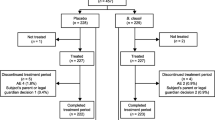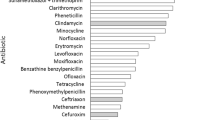Abstract
Diarrhea is considered as an important cause of morbidity and mortality, even though one of the main reasons of death following diarrhea is initiated by dysentery. In recent years, the consumption of probiotics has been proposed for the treatment of infectious diarrhea. Despite most of the studies on probiotics have focused on acute watery diarrhea, few studies in the field of dysentery have found beneficial effects of probiotics. This study is a randomized double-blind clinical trial. The patients were randomly placed into control and case groups. In the intervention group, the patients received probiotics in the form of Kidilact® sachet, which contained high amounts of 7-strain friendly bacteria strains of Lactobacillus casei, Lactobacillus acidophilus, Lactobacillus rhamnosus, Lactobacillus bulgaricus, Bifidobacterium infantis, Bifidobacterium breve, and Streptococcus thermophiles. On the other hand, the patients in the control group received placebo sachets on a daily basis for 5 days. It is notable that the treatment protocol of acute dysentery was done on both groups. The results of this study showed significant differences in the duration of blood in diarrhea between probiotic consumers (2.62 days) and the control group (3.16 days) (P value = 0.05). Additionally, significant differences in the average length of hospitalization in probiotic consumers (3.16 days) and control (3.66 days), (P value = 0.02) could be claimed that the consumption of probiotics is effective in reducing the duration of dysentery and diarrhea. The results of this study suggest that the use of probiotics can be effective in reducing the duration of blood in diarrhea. This study was also recorded in the Iran center of clinical trials registration database (IRCT2014060617985N1).
Similar content being viewed by others
References
Liu L et al (2015) Global, regional, and national causes of child mortality in 2000–13, with projections to inform post-2015 priorities: an updated systematic analysis. Lancet 385(9966):430–440
Organization, W.H (2005) The treatment of diarrhoea: a manual for physicians and other senior health workers. WHO, Geneva 2013, WHO/CDD/SER/80.2
Grenov B, et al. (2017) Validation of a simple stool diary used by caregivers to document diarrhea among young children in a low-income country. J Pediatr Gastroenterol Nutr. doi:10.1097/MPG.0000000000001462
Grandy G et al (2010) Probiotics in the treatment of acute rotavirus diarrhoea. A randomized, double-blind, controlled trial using two different probiotic preparations in Bolivian children. BMC Infect Dis 10(1):253
Koletzko S, Osterrieder S (2009) Acute infectious diarrhea in children. Dtsch Arztebl Int 106(33):539–547
Canani RB et al (2007) Probiotics for treatment of acute diarrhoea in children: randomised clinical trial of five different preparations. BMJ 335(7615):335–340
Cucchiara S et al (2002) New therapeutic approach in the management of intestinal disease: probiotics in intestinal disease in paediatric age. Dig Liver Dis 34:S44–S47
Lotfi A et al (2016) Comparing the effects of two feeding methods on metabolic bone disease in newborns with very low birth weights. Glob J Health Sci 8(1):249–254
Boirivant M, Strober W (2007) The mechanism of action of probiotics. Curr Opin Gastroenterol 23(6):679–692
Petrof EO (2009) Probiotics and gastrointestinal disease: clinical evidence and basic science. Anti-Inflammatory & Anti-Allergy Agents in Medicinal Chemistry (Formerly Current Medicinal Chemistry-Anti-Inflammatory and Anti-Allergy Agents) 8(3): p. 260–269
Sharif MR et al (2016) The effect of a yeast probiotic on acute diarrhea in children. Probiotics and Antimicrobial Proteins 8(4):211–214
Allen SJ et al (2011) Probiotics for treating acute infectious diarrhoea. Sao Paulo Medical Journal 129(3):185–185
Billoo A et al (2006) Role of a probiotic (Saccharomyces boulardii) in management and prevention of diarrhoea. World J Gastroenterol 12(28):4557
O’Ryan G,M et al (2014) Management of acute infectious diarrhea for children living in resource-limited settings. Expert Rev Anti-Infect Ther 12(5):621–632
Johnston BC et al (2012) Probiotics for the prevention of Clostridium difficile–associated diarrhea: a systematic review and meta-analysis. Ann Intern Med 157(12):878–888
Applegate JA et al (2013) Systematic review of probiotics for the treatment of community-acquired acute diarrhea in children. BMC Public Health 13(3):S16
Guandalini S (2011) Probiotics for prevention and treatment of diarrhea. J Clin Gastroenterol 45:S149–S153
Moorthy G, Murali MR, Devaraj SN (2009) Lactobacilli facilitate maintenance of intestinal membrane integrity during Shigella dysenteriae 1 infection in rats. Nutrition 25(3):350–358
Htwe K et al (2008) Effect of Saccharomyces boulardii in the treatment of acute watery diarrhea in Myanmar children: a randomized controlled study. AmJTrop Med Hyg 78(2):214–216
Guarner F, Malagelada J-R (2003) Gut flora in health and disease. Lancet 361(9356):512–519
Gorbach SL (2000) Probiotics and gastrointestinal health. Am J Gastroenterol 95(1):S2–S4
Hempel S et al (2012) Probiotics for the prevention and treatment of antibiotic-associated diarrhea: a systematic review and meta-analysis. JAMA 307(18):1959–1969
Simpson H, Campbell B (2015) Review article: dietary fibre–microbiota interactions. Aliment Pharmacol Ther 42(2):158–179
Marrazzo, J. M., & Apicella, M. A. (2014). Neisseria gonorrhoeae (Gonorrhea). In Mandell, Douglas, andBennett’s Principles and Practice of Infectious Diseases. (Vol. 2). Elsevier Inc. pp. 2446-2462.e3. doi:10.1016/B978-1-4557-4801-3.00214-9
Basu S et al (2007) Efficacy of Lactobacillus rhamnosus GG in acute watery diarrhoea of Indian children: a randomised controlled trial. J Paediatr Child Health 43(12):837–842
Francavilla R et al (2012) Randomised clinical trial: Lactobacillus reuteri DSM 17938 vs. placebo in children with acute diarrhoea—a double-blind study. Aliment Pharmacol Ther 36(4):363–369
Jalali HK et al (2016) Antagonistic activity of Nocardia brasiliensis PTCC 1422 against isolated Enterobacteriaceae from urinary tract infections. Probiotics and antimicrobial proteins 8(1):41–45
Ferdosian M et al (2015) Identification of immunotopes against Mycobacterium leprae as immune targets using PhDTm-12mer phage display peptide library. Trop J Pharm Res 14(7):1153–1159
Kashani HH, Moniri R (2015) Expression of recombinant pET22b-LysK-cysteine/histidine-dependent amidohydrolase/peptidase bacteriophage therapeutic protein in Escherichia coli BL21 (DE3). Osong public health and research perspectives 6(4):256–260
Kashani HH, et al. (2012) Synergism effect of nisin peptide in reducing chemical preservatives in food industry. Life Science Journal 9(1):496–501
Dehghani R et al (2016a) The identification of bacterial flora in oral cavity of snakes. Comp Clin Pathol 25(2):279–283
Dehghani R et al (2016b) Fungal flora in the mouth of venomous and non-venomous snakes. Comp Clin Pathol 25(6):1207–1211
Kashani HH et al (2013) Expression of galectin-3 as a testis inflammatory marker in vasectomised mice. Cell J 15(1):11–18
Nikzad H et al (2013) Expression of galectin-8 on human endometrium: molecular and cellular aspects. Iran J Reprod Med 11(1):65–70
Korviakova E (1999) Use of loading doses of bifidumbacterin forte for treatment of patients with acute enteric infections. Zhurnal mikrobiologii, epidemiologii, i immunobiologii (6): p. 58–61
Utemuradova G (2008) Etiology of acute enteric n in children with arid zone and effect of probiotics. Zhurnal mikrobiologii, epidemiologii, i immunobiologii (3): p. 98–100
Vandenplas Y et al (2007) Probiotics in infectious diarrhoea in children: are they indicated? Eur J Pediatr 166(12):1211–1218
Erdoğan Ö, et al. (2012) The comparition of the efficacy of two different probiotics in rotavirus gastroenteritis in children. J Trop Med 2012;787240. doi:10.1155/2012/787240
Guarino A et al (2014) European Society for Pediatric Gastroenterology, Hepatology, and Nutrition/European Society for Pediatric Infectious Diseases evidence-based guidelines for the management of acute gastroenteritis in children in Europe: update 2014. J Pediatr Gastroenterol Nutr 59(1):132–152
Mirnejad R et al (2013) The antimicrobial effect of lactobacillus casei culture supernatant against multiple drug resistant clinical isolates of Shigella sonnei and Shigella flexneri in vitro. Iranian Red Crescent medical journal 15(2):122–126
Acknowledgements
The researcher wishes to express his appreciation to the full cooperation of the patients who participated in this study and the Clinical Research Center of Shahid Beheshti Hospital. The financial support for this research was provided by a grant no. 93137 from the Research Deputy of Kashan University of Medical Sciences.
Author information
Authors and Affiliations
Corresponding author
Ethics declarations
Ethical Responsibilities of Authors
This paper is our original unpublished work and it has not been submitted to any other journal for reviews.
Conflict of Interest
The authors declare that they have no competing interests.
Rights and permissions
About this article
Cite this article
Sharif, A., Kashani, H.H., Nasri, E. et al. The Role of Probiotics in the Treatment of Dysentery: a Randomized Double-Blind Clinical Trial. Probiotics & Antimicro. Prot. 9, 380–385 (2017). https://doi.org/10.1007/s12602-017-9271-0
Published:
Issue Date:
DOI: https://doi.org/10.1007/s12602-017-9271-0




